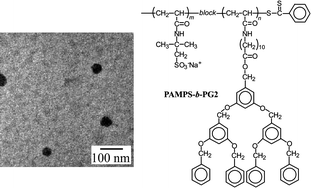Well-defined amphiphilic diblock copolymers (PAMPS-b-PG2) composed of a hydrophilic linear polyelectrolyte and hydrophobic blocks bearing pendent dendritic moieties was synthesized via reversible addition–fragmentation chain transfer (RAFT) controlled radical polymerization of 3,5-bis[3′,5′-bis(benzyloxy)benzyloxy]benzyl 11-acrylamidoundecanoate (G2) using a poly(sodium 2-(acrylamido)-2-methylpropanesulfonate) (PAMPS) based macro-chain transfer agent. Degrees of polymerization of PAMPS and PG2 blocks were 71 and 3, respectively. The polydispersity index was 1.25 as estimated from GPC. Hydrophobic association of the PG2 blocks in aqueous solutions was suggested from restricted motions of the dendritic moieties as observed by 1H NMR in D2O. A fluorescence spectrum of 8-anilino-1-naphthalenesulfonic acid, ammonium salt hydrate indicated that the fluorescence probe was solubilized in the hydrophobic domain formed from the polymer aggregate in water. The formation of polymer aggregates was indicated by light scattering data. The hydrodynamic radius (Rh) of the polymer aggregate was independent of the polymer concentration.

